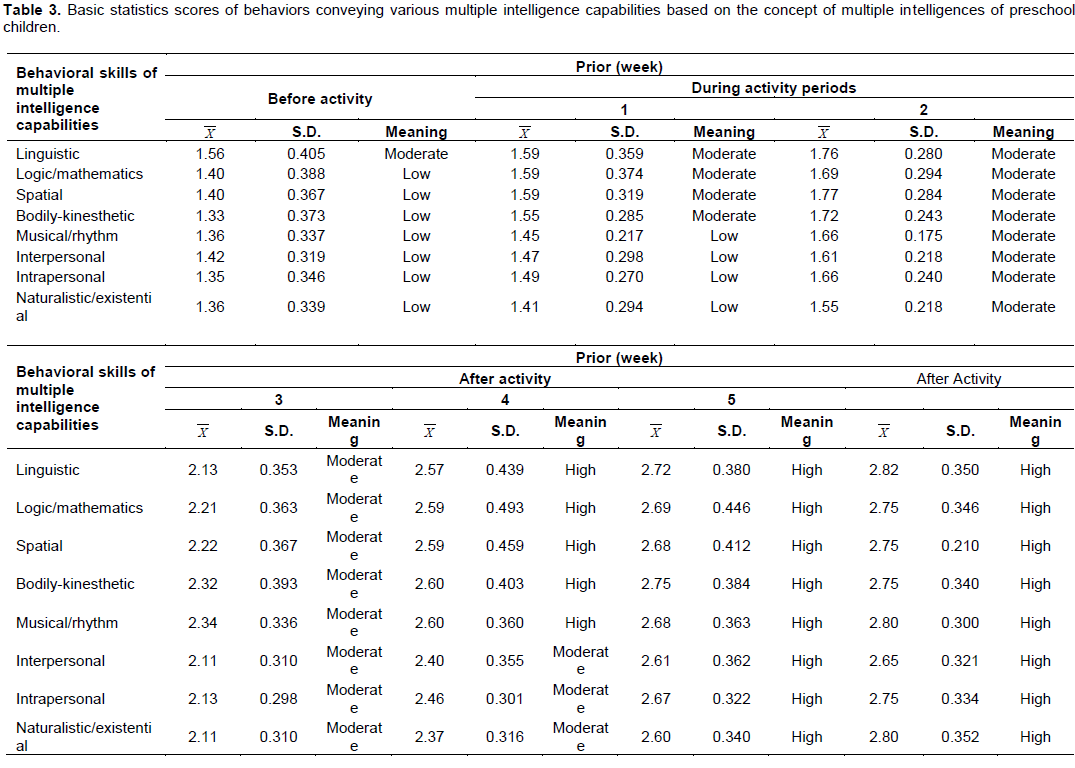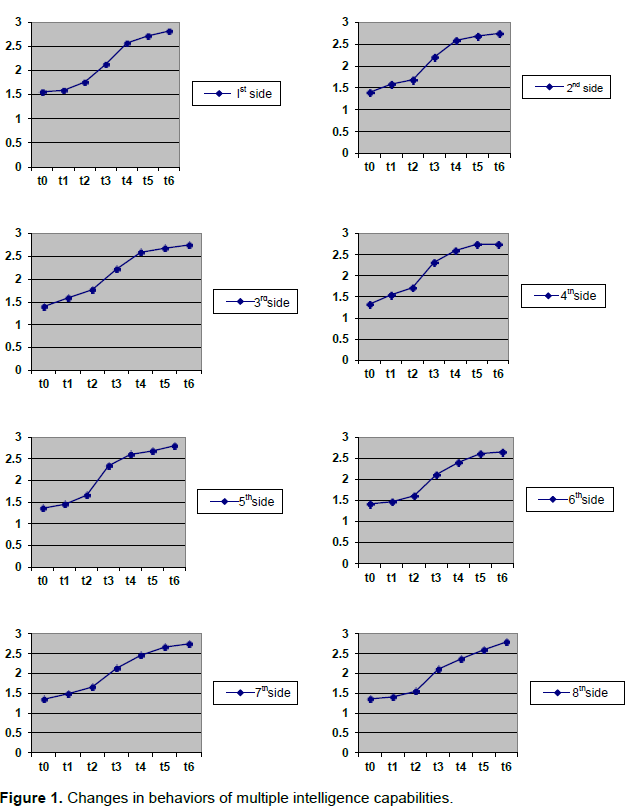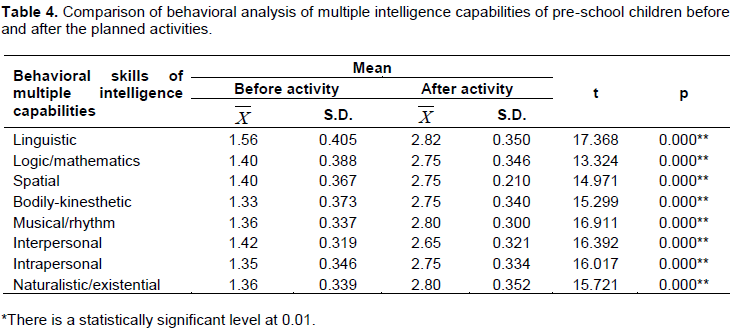ABSTRACT
The aim of this research is to promote multiple intelligence capabilities for Early Childhood Care Center of a Sub-district Administration Organization in Chaiyaphum Province. The sample applied were 61 children aging between 3 and 5 years old at Child Development Center, Tambon Ban Kok, Amphoe Chaturus, Chaiyaphum Province, who were selected through the purposive sampling method. Caretakers were interviewed and the instruments were integrated planning of activities to promote abilities and the behavioral notification form for multiple intelligence capabilities. The study indicated that there were high behavioral changes of multiple intelligence capabilities of the children during all planned activities. Furthermore, comparison of multiple intelligence capabilities of child behavior before and after the activities, such as linguistic, logic, mathematics, spatial, physical and body-movement, music and rhythm skills, ability of human relationship, self-understanding, love of natural environment and higher level of existence were applied. Its result was statistical significant at 0.01.
Key words: Multiple intelligence capabilities, childhood, Chaiyaphum Province.
The development of any field depends on the area of research, educational applications and the theoretical and practical innovations brought to the field. In this case, the development is subjected to the comprehension of the present status in the relevant field, and starting from this, to the identification of the innovations brought to the field. In other words, in order to ensure that the field will be updated continuously, it is important to realize the drawbacks and the defects in the present situation or the gaps in the field and to promote alternatives to solve these deficiencies. Researchers also need to be in line with evolving databases to stay up to date by following scientific works such as theses, articles, and books published via various editorial boards (Gilbert and Trudel, 2004). In these scientific works, it is shown that numerous researchers mutually structure the issues.
Early childhood is vital to the future since it is such a critical period of human life. The effects of parental upbringing and experiences that children have had in the early stages of life are the foundation on which all other developments, physical, intellectual, social and personality are built. Children learn quickly by stimulation through their five senses while playing or from their parents and others around them. This stimulation helps their brain nervous fibers grow extensively. Children can easily learn to live positively and be logical in their attitude. Little children will learn everything while they are young. If they are not properly guided, they will have a hard time learning things, or will be unable to learn at all (Yaowapa Dejakup, 1999).
Due to such aforementioned importance, many countries worldwide have stated their visions in development of early childhood education. For instance, the United States of America has clearly targeted that in 2000, education must be readily provided for every child in America who legitimately enters school. Meanwhile, New Zealand has an increasing interest in child nurturing (Department of Local Administration, 2006). Thailand has also been emphasizing on the importance of early childhood education development. As can be seen in the B.E. 2542 National Education Act, Article 81: (1) states that places for early childhood education must be organized in special places such as child care centers, child development centers, early religious childhood development centers, early intervention centers for disabled children and centers for children with special needs, or any other early childhood development institutions. The goal is to get all children from early childhood to receive better development and be better prepared in all aspects before entering the education system. An appropriate activity is essential to fit each child in order to encourage full individual potential development. The learning activities should be child-centered since each child has different abilities.
For the above reasons, the education circles have turned their attention from intellectual development of students to intellectual and knowledgeable in various aspects. At present, a well-known concept of student development is Multiple Intelligences Theory which is aimed at boosting student abilities in all aspects and taking into account the different potential of student (Vareerut Supranee, 2541, cited in Pimpun Thongprasit, 2005). Howard Gardner, psychologist and educator, interested in studying human intelligence and potentiality, created the Theory of Multiple Intelligences, with his belief that intelligence was the ability of an individual to be biologically expressed. It was a combination of genetics and environment which create a source of ideas. In general, people possess many aspects of intelligence. Each aspect could be latent or expressed intellectually. Gardner differentiated these intellectual aspects into: Linguistic Intelligence, Logic/Mathematical Intelligence, Spatial Intelligence, Bodily-Kinesthetic Intelligence, Musical Intelligence, Interpersonal Intelligence, Intrapersonal Intelligence, Naturalistic Intelligence, and Existential Intelligence. Many intellectual aspects can be improved by developing the individual potential suitable for each person. Even though each person possesses different levels of intelligence, all aspects of intelligence can still be developed for improvements (Gardner, 1987, 1993, 1999, cited in Asci and Demircioglu. 2004; Yaowapa Techakupta, 1999).
Howard Gardner’s Multiple Intelligence Theory was first published in Howard Gardner’s book, Frame of Mind (1983), and quickly became established as a classical model by which to understand and teach many aspects of human intelligence, learning style, personal and behavior in education and industry. Howard Gardner initially developed his ideas and theory on multiple intelligences as a contribution to psychology; however Gardner’s theory was soon embraced by education, teaching and training communities, for whom the appeal was immediate and irresistible – a sure sign that Gardner had created a classic reference work and learning model.
Many educators had the experience of not being able to reach some students until presenting the information in a completely different way or providing new options for student expression. Perhaps it was a student who struggled with writing until the teacher provided the option to create a graphic story, which blossomed into a beautiful and complex narrative. Or maybe it was a student who just could not seem to grasp fractions, until he created them by separating oranges into slices. Because of this kind of experiences, the theory of multiple intelligences resonates with many educators. It support what we all know to be true.
The quality development of human beings according to the Multiple Intelligences Theory could be another new way of human quality development. It could be used to develop human quality to become the perfect one. The development of learners’ intellectual capabilities in various aspects, according to the Multiple Intelligences Theory, was engrossed in promotion of individual learners’ capabilities. People did not have only intellectual capabilities. If his potentiality had been well developed, it would be prominent or it would be in need of more development. Suitable learning activities must be organized and be supported by teachers, parents and others involved.
The importance of the Multiple Intelligences Theory mentioned above will allow teachers or baby-sitters to understand various aspects of multiple intelligences of young children. Dominant intellectual aspects of children will indicate their learning style. In other words, children will excel better in learning from what he is most capable of. Activity arrangements to develop children readiness should be diversified. These learning activities should encourage young children to use their multiple intelligences in accordance with the current education system. From the reason, researchers have developed an integrated planning of activities to promote the multiple intelligences in 9 aspects for young children into 4 main combined activities: Rhythm and Movement Activities, Free Activities, Creative Activities, and Experience-Enhancement Activities by adopting a learning experience in a local learning environment for young children. The results of this research will be guidelines for teachers, educational administrators, as well as those involved in education administration for young children to arrange suitable activities to help enhance multiple intelligence capabilities of preschool kids.
The objective
To enhance the multiple intelligence capabilities of pre-school children in Early Childhood Care Center at a Sub-district Administrative Organization in Chaiyaphum Province.
Scope of research
1. Population: 3,750 children in Child Development Center of Sub-district Administrative Organization, Amphoe Chaturus, Chaiyaphum.
2. Sampling: Purposive sampling of 61 pre-school children at Ban Nonthong Child Development Center, Tambon Ban Kok Sub-district Administrative Organization, Amphoe Chaturus, Chaiyaphum Province.
In order to develop integrated activities to enhance multiple intelligence capabilities in Child Development Center of Sub-district Administration Organization in Chaiyaphum, the researchers had reviewed related literature, concepts, theories and documents on curriculum designs, education philosophy, early childhood education programs, learning theories, Theory of Multiple Intelligences, promotion of multiple intelligences to pre-school children and managements of integrated learning experiences of pre-school children. Furthermore, the context of Ban Nonthong Child Development Center at Tambon Ban Kok Sub-district Administration Organization, Amphoe Chaturus, Chaiyaphum, had been studied as a guideline for implementation and utilization of learning resources
available in the local environment as shown in Table 1.
Research design
This research is experimental (experimental design), and was conducted in a single group trial, measuring before and during data collecting processes. It is a combined application of research designs for One Group, Pre-test/Post-test design and One Group, Time - Series design (Luan Saiyot and Angkana Saiyot, 1995). Behaviors of multiple intelligence
capabilities of selected sampling units were observed from normal activities once a week before the trial. Then the samples were tested by organizing experience as an integrated plan to enhance multiple intelligence capabilities of pre-school children for a period of 5 weeks and observed the behavior of multiple intelligence capabilities every week. There was another observation in the behavior of the children within 1 week of the first trial. The experimental design is shown on Table 2.
FINDINGS
Basic statistics of the behaviors that express various multiple intelligence capabilities based on the concept of multiple intelligences of pre-school children appear on Table 3. The analytical results in Table 3 show that before the integrated planned activities the average scores of the behavior of multiple intelligence capabilities of pre-school children are moderate on all aspects. After the activities to enhance development of multiple intelligence capabilities of pre-school children, the children obtained the average scores of the behavior of multiple intelligence capabilities at a high level in all areas: Linguistic, logic/mathematics, spatial, bodily-kinesthetic, musical/rhythm, interpersonal, intrapersonal, and naturalistic/existential intelligences (Figure 1).


The analyses compared the behaviors of multiple intelligence capabilities of pre-school children before and after the planned activities are shown in Table 4. Table 4 comparison of behavioral analyses of multiple intelligences of pre-school children before and after the events to enhance the capabilities of pre-school children, shows that multiple intelligences of the children in all areas of linguistic, logic/mathematics, spatial, bodily-kinesthetic, musical/rhythm, interpersonal, intrapersonal, and naturalistic/existential intelligences, have increased
to a higher level of statistical significance of 0.01.

a
Basic statistics of the behaviors that express various multiple intelligence capabilities based on the concept of multiple intelligences of pre-school children appear on Table 3. The analytical results in Table 3 show that before the integrated planned activities the average scores of the behavior of multiple intelligence capabilities of pre-school children are moderate on all aspects. After the activities to enhance development of multiple intelligence capabilities of pre-school children, the children obtained the average scores of the behavior of multiple intelligence capabilities at a high level in all areas: Linguistic, logic/mathematics, spatial, bodily-kinesthetic, musical/rhythm, interpersonal, intrapersonal, and naturalistic/existential intelligences (Figure 1).


The analyses compared the behaviors of multiple intelligence capabilities of pre-school children before and after the planned activities are shown in Table 4. Table 4 comparison of behavioral analyses of multiple intelligences of pre-school children before and after the events to enhance the capabilities of pre-school children, shows that multiple intelligences of the children in all areas of linguistic, logic/mathematics, spatial, bodily-kinesthetic, musical/rhythm, interpersonal, intrapersonal, and naturalistic/existential intelligences, have increased
to a higher level of statistical significance of 0.01.
In comparing the pre and the post experiment, pre-school children who had been organized to enhance development of multiple intelligence capabilities obtained higher level of multiple intelligence capabilities in all areas at the statistical significant level of 0.01. The reasons may be while the pre-school children participated in planned procedures that enhanced learners to develop their multiple intelligence capabilities, they had the opportunity to learn through their direct experiences with the support of the teachers. Also, the planned events were in the form of integrated activities through playing according to the principles of learning through experiences for children of pre-school curriculum B.E. 2546 (Department of Curriculum and Instruction Development, 2546). Through the integration of 4 main activities together, the operation had become flexible and agile. Children participated in every activity which applied the learner-centered approach. In addition, these activities encouraged each child to express his feelings and own capabilities, and gave the child opportunities to use his ideas, to solve problems, to research and test, to reason, to create media of communication from his understanding and imagination. Besides, the process will cause aesthetic judgment to encapsulate in the mind and feelings of the child which is the essential foundation for the intellectual development and growth of children in the future, in accordance with the concept of “Learning by Doing” of Dewey (Dewey, n.d., cited in Yaowapa Dechakupt, 1999). The concept states that children learn better from doing and direct experience themselves through observation, research, experiment, and participation in solving problems and activities with friends. In consistence with the study of Chaiyapreuk Serirak and Bung-orn Serirat (2543), they founded that the learning management of multiple intelligence development to develop outstanding talents and versatile capabilities of every student remarkably improved both in his outstanding talents and versatile capabilities. Moreover, it was clearly shown in the activities that the teachers wanted to enhance development of a specific outstanding talent not only affected the desired skill, but also influenced the development of other involved intellectual capabilities of the students. The research of the experience-based management model of multiple intelligences for cognitive development of pre-school children of Poonsiri Moon-inta (2008) also confirmed that after the experience-based activity events the average mean scores were higher than those of the scores before the events, and the scores of the behavioral multiple intelligence capabilities in all 8 aspects were at a high level. Boonma Choekula (2009) conducted a study on the second year kindergarten children on the learning activity development based on the theory of multiple intelligences. The result indicated that after the experiments the children were capable of multiple intelligences in all 8 aspects higher than before the experiments at a statistically significant level of 0.01.
Suggestions on making use of the research results include:
1. Teachers of child care should pay more attention to the differences among individual children so that the experience-based arrangements for children should take into account the multiple intelligence capabilities that are critical for the readiness of pre-school children. This issue will lead to the balanced creation of giving suitable experiences for every child. The formats of diverse and flexible experiences according to the differences of multiple intelligence capabilities of pre-school children are required. They will better allow children to utilize their availably potential multiple intelligences. Also, the experienced-based arrangements will help preschool children to use their inferior multiple intelligence capabilities to a higher developed level.
2. Before making use of the integrated-activity plans to promote the multiple intelligence capabilities of preschool children, the 4 main integrated-activity arrangements, including movement activities, creative activities, unstructured activities, and experience-enhancement activities, as well as, the process of conveying the activity managements through media and evaluation, should be thoroughly studied and understood.
3. Local wisdom or local resources are knowledge resources close to the children. The combination of integrated-experience arrangements in the real environment and the correct academic theories with the developments in all aspects, such as educational, social or economic, is extremely valuable. It is something that must be developed to preserve to remain modish of the period under the globalization society. Furthermore, it is essential that children be taught from preschool because their abilities will become very valuable to the country.
4. There should be dissemination of the knowledge and the techniques of integrated- experience managements to develop the multiple intelligence capabilities of pre-school children for other childcare teachers, and other related learning institutes.
Suggestions for future research include:
1. Teaching model of Child Development Center by local wisdom of Department of Local Administration should be deployed in research of children with specific aspects. For instance, to promote linguistic readiness, thinking, mathematics, sciences, or any other skills that will lead to an appreciated development of the real value in order to create learning process from the basis of good culture.
2. There should be study on other forms of arrangements of integrated activities to develop pre-school children’s readiness by usage of the local wisdom or local knowledge resources such as contemplative education, project-approached education, etc.
The authors have not declared any conflict of interests.
REFERENCES
|
Asci Z, Demircioglu H (2004). Coklu Zeka Temelli Ogretimin Dokuzuncu Smif Ogrencilerinin Ekoloji Basarisna. Ekoloji Rutumlarina ve Coklu Zekalarina E Uthai Dulyakasem. Learning Education. Bangkok: Sodsri-Saritwong Foundation, 1999.
|
|
|
|
Boonma C (2009). Learning-activity Development based on the Theory of Multiple Intelligences of the Children in the Secondary Year of a Kindergarten. Thesis M.Ed. (Curriculum and Instruction), Sakon Nakhon: Sakon Nakhon Rajabhat University.
|
|
|
|
Luan S, Angkhana S (1995). Educational Research Technique (5th ed.). Bangkok: Suriwiriyasarn,
|
|
|
|
Thongprasit P (2005). A Study of Multiple Intelligence Capability of Preschool Children Receiving Organized Activities by the Scientific Process. Thesis M.Ed. (Preschool Education). Bangkok: Srinakharinwirot University.
|
|
|
|
Yaowapa D (1999). Education Management for Preschool Children. Bangkok: Mac Publishing, Workshop on "The Development of the Curriculum and the Learning Process by Multiple Intellectual Learning". Pathum Thani, 2002.
|